Huge area, dozens of dead, mass evacuation: what you need to know about the deadly fires in Australia
Bushfires raging across Australia have burned more than 12 million acres (almost 5 million hectares) - an area roughly equal to the US states of Vermont and New Hampshire combined. Smoke from the blaze in the southeast of the country is visible from space and is spreading so far that it is causing haze in New Zealand more than 1000 miles (1600 km) away, writes Time.

Фото: Depositphotos
The season of fires in Australia is far from over, and it has already become one of the most intense in the history of the country.
“The intensity, the scale, the number, the geographic range, the fact that the fires are happening at the same time, and the types of environments that are burning are all together extraordinary,” said David Bowman, professor of pyrogeography and fire science and director of the Fire Center Research Center at University of Tasmania.
“We are in the middle of a war situation... mass evacuations, military involvement, extremely exhausted firefighting campaigns, it is difficult to explain,” he added.
As a result of forest fires, at least 19 people died, dozens of people went missing. Hundreds of houses were destroyed. The military deployed ships and planes to deliver supplies to cities affected by fires and to evacuate residents who were cut off by fire from safe areas.
The situation is expected to get worse.
Here's what you need to know about the crisis unfolding in Australia.
The wind change has just cleared the far east coast of #Victoria. The graphic shows smoke haze concentrated on the change as it moves over #Gippsland and esatern Bass Strait. Thanks to @JMA_kishou for enabling rapid scan imaging of its Himawari-8 satellite #VicFires pic.twitter.com/jNqrCJ2b5D
- Bureau of Meteorology, Victoria (@BOM_Vic) January 4, 2020
How extensive are the fires?
According to the Associated Press, around 12,35 million acres of land (nearly 5 million hectares) burned across Australia. By comparison, California forest fires in 2018, which the California Department of Forestry and Fire Department said were “the deadliest and most destructive forest fire season in history” in the state, burned an area of less than 2 million acres (809 thousand hectares) .
The risk of forest fire is currently highest in New South Wales and Victoria, the most populous states, during the Australian summer, which lasts from December to February, but a state of emergency was declared in New South Wales in mid-November due to the fire season . In southern Australia and Tasmania, the fire season continues until fall.
Owen Price, an assistant professor at the Center for Environmental Risk Management in a Forest Fire at Wollongong University, told the publication that approximately 30% of the forest in New South Wales was burned, but that percentage could increase to 50% over the coming weekend.
Our people are highly trained & professional, but not always able to complete the mission on first try.
This video shows how heavy smoke from bushfires has prevented some C27J & C130J flights from reaching #Mallacoota & #Merimbula #AusAirForce #AustralianFires #YourADF pic.twitter.com/PhNjNIUVHf- Air Commander (@RAAF_ACAUST) January 6, 2020
What's happening?
As of Friday, Australia recorded at least 200 active fires. Just this week, 10 deaths were confirmed in Victoria and New South Wales. Victoria Prime Minister Daniel Andrews has announced a state of disaster for several areas, authorities are calling for evacuation from large areas of the state. Andrews on his Twitter said that 28 state residents were missing.
In the resort town of Mullakuta, where at the beginning of this week about 4000 residents were forced to flee to the coast due to the spread of fire, the military is helping to evacuate. Australia's Secretary of Defense tweeted pictures of evacuated residents of Mallacuta.

Photo: twitter.com/lindareynoldswa
In New South Wales, where Sydney is located, firefighters are fighting more than 130 fires, according to the state fire service. According to her, more than 1300 houses were destroyed in the state. State authorities announced a third state of emergency this week starting in mid-November. The seven-day state of emergency began Friday morning, January 3.
On the subject: California's deadliest fire was caused by equipment that has not been repaired for years
The Victoria Meteorological Bureau published images of a foggy sky and stated that visibility at the airport in Albury, on the border of New South Wales and Victoria, is only about 1 feet (less than 600 meters).
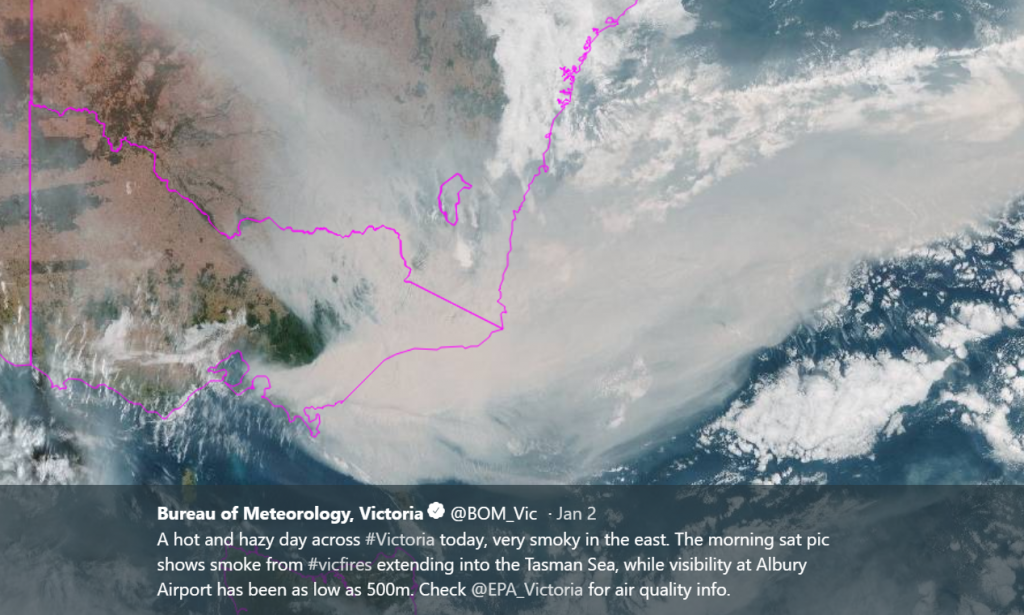
Photo: twitter.com/BOM_Vic
The map showed "very harmful" and "dangerous" levels of air quality in parts of New South Wales, Victoria and the metropolitan area of Australia.
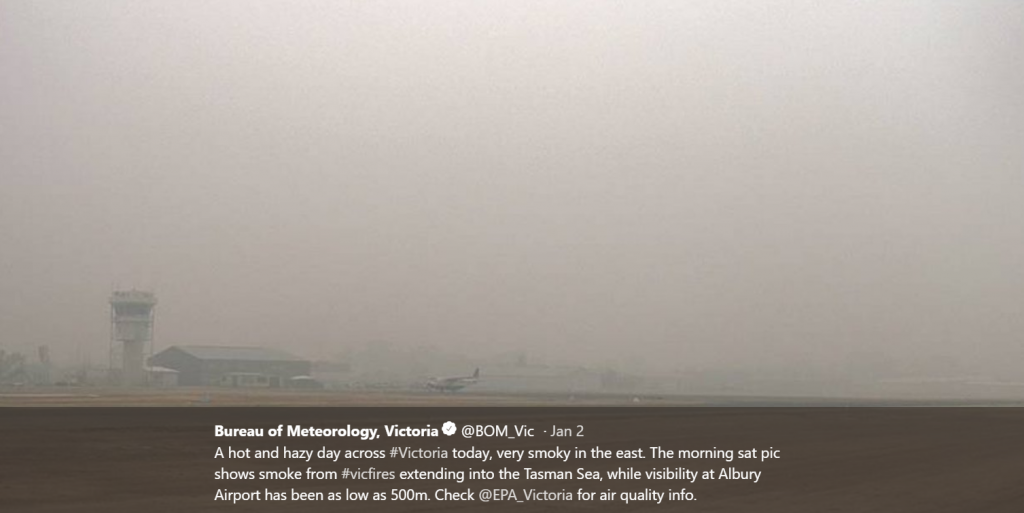
Photo: twitter.com/BOM_Vic
According to the Australian Bureau of Meteorology, the haze from fires has had an effect on distant places like New Zealand. A NASA satellite image captured most of the smoke from fires spreading across the Tasman Sea.
Fires will get worse
Although Australia is getting colder this week, warmer weather is expected to exacerbate the weekend crisis. The Victoria Meteorological Bureau has predicted “serious” and “extreme” fire hazard ratings for several parts of the state due to high temperatures and changing winds.
Bauman, a researcher from Tasmania, says the scale of already blazing fires means that when the air heats up, the fires intensify rapidly.
"Every time you weather the next 24 hours, fires just explode again, bigger fires, new fires, new fire fronts and new lightning strikes... it's the devil's rattle," the expert said.
“Here in Tasmania the whole east coast could flare up. There's a big chunk of forest around Melbourne, tall forests... there's still a lot that could burn in south-west Australia,” Bowman said.
“The door is open, and we don’t know how it will end,” the expert added. “Most of Australia's vegetation is very flammable, the fire has a lot of work to do, it has the ability to keep burning, it won't run out of fuel.”
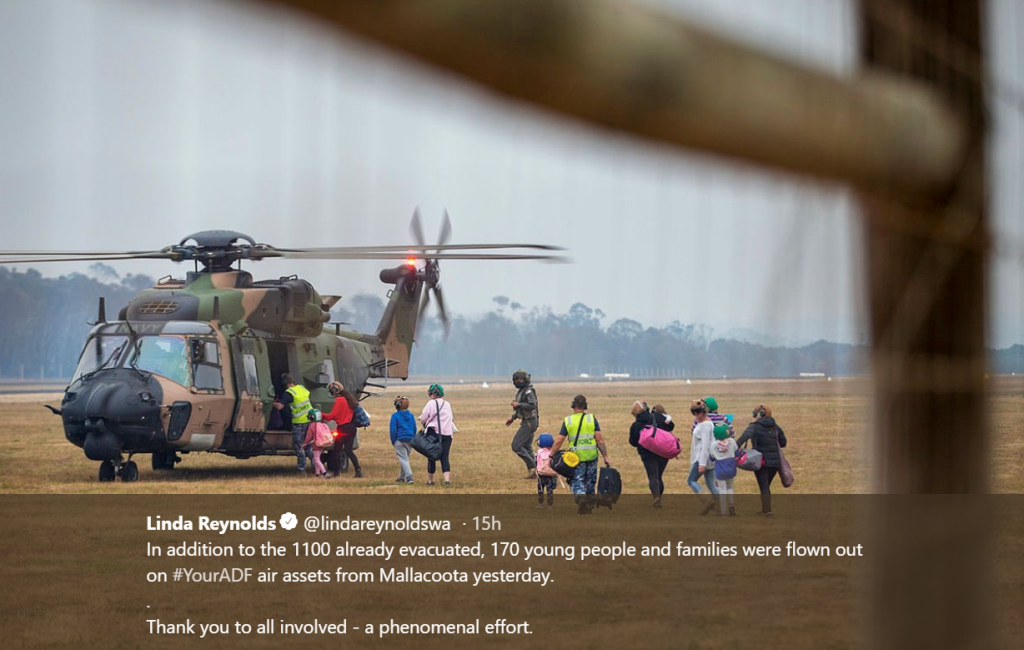
Photo: twitter.com/lindareynoldswa
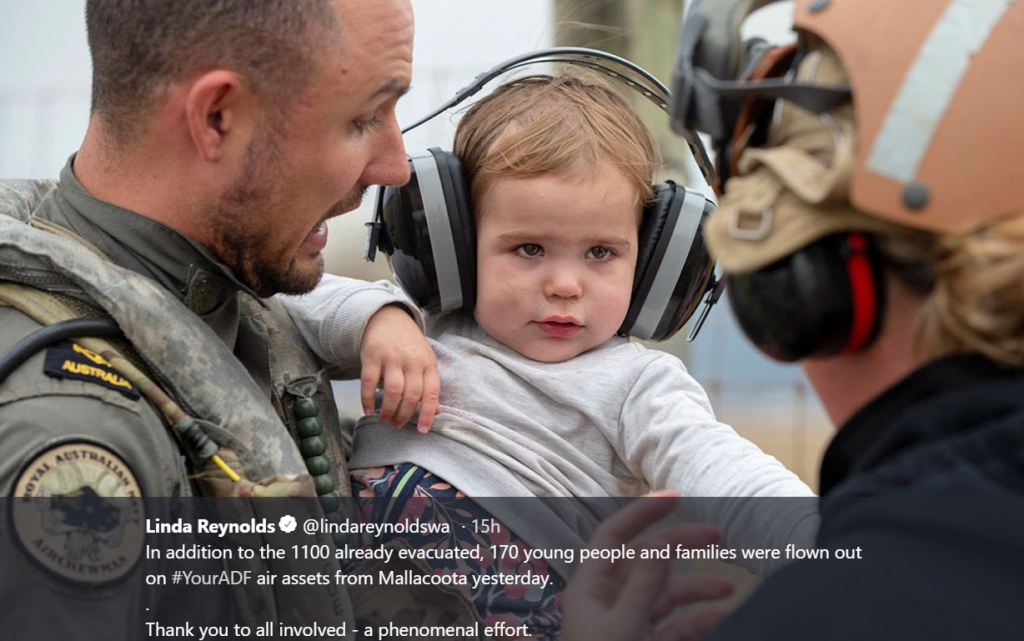
Photo: twitter.com/lindareynoldswa
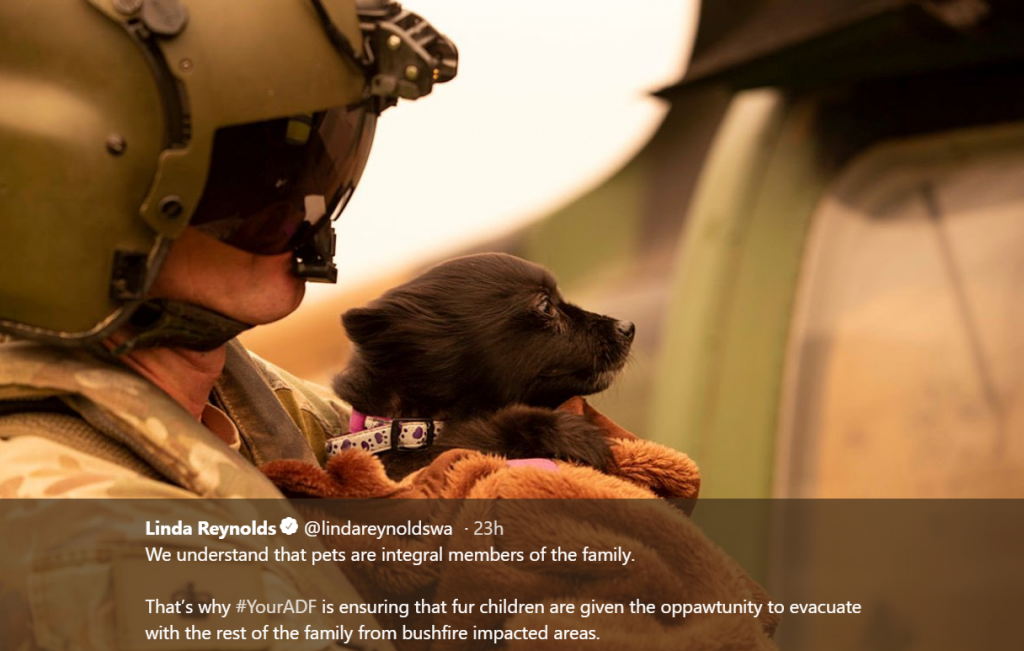
Photo: twitter.com/lindareynoldswa
What role does climate change play?
Experts say climate change has contributed to a historically intense fire season.
“Climate change is making fires worse,” says Lesley Hughes, professor of biology at Macquarie University and climate adviser to the Australian Climate Council. “This has contributed to the ongoing decline in rainfall and therefore the impact of the current drought we are experiencing, particularly in south-east Australia.”
Hughes adds that climate change can also be the cause of more frequent and more severe heatwaves in the country. According to the Australian Bureau of Meteorology, 2019 was the hottest year in the history of observations: temperatures reached about 2,7 degrees Fahrenheit above the long-term average.
“If you have a combination of very hot, dry days, high winds and very dry fuels, if you get a spark, you have the conditions ripe for a very serious wildfire,” Hughes says.

Photo: video frame YouTube / Washington Post
Despite the crisis, Australian Prime Minister Scott Morrison argues that there is no direct link between greenhouse gas emissions in Australia and the severity of fires burning across the country. He acknowledged, however, that climate change could affect forest fires and the duration of the season. According to Climate Analytics, a climate protection monitoring team, Australia has one of the highest carbon dioxide emissions per capita in the world.
On the subject: What is the uniqueness of fires in California and why in the future it will only get worse
Hughes says the government’s position on climate change is undermining its ability to respond to the crisis.
“If you don't accept the science — which has been saying for at least 30 years that we need to prepare for and mitigate these conditions — then you walk into a disaster like this completely unprepared,” she added.
no. 35 Squadron and their C-27J Spartans have helped evacuate fire-affected Mallacoota. ADF aircraft flew 170 people out of harms way on Sunday. Sorties will continue until everyone willing has been transported. #opbushfireassist #ausairforce #australiafires pic.twitter.com/vEhlZi8OWD
- Royal Australian Air Force (@AusAirForce) January 6, 2020
Political reaction
The Australian Prime Minister was faced with a negative reaction to the crisis, both because of his reluctance to associate Australia's emissions with forest fires, and because of his reaction to fires. Protests broke out in Morrison’s office in December when some protesters demanded action to combat climate change, while others criticized Morrison for taking vacation in Hawaii during the fire crisis. The prime minister interrupted his family vacation and apologized for the trip.
Alex Oliver, research director at the Lowy Institute Sydney think tank, said the Morrison government’s stance on climate change has angered some Australians who see climate change as a serious problem and want the government to take more decisive action.
On the morning of January 4, Morrison announced the cancellation of an economic visit to India to head the National Security Commission. Two days earlier, he had encountered the furious inhabitants of a city ravaged by a forest fire, who scolded him and insulted him while visiting their village. Some residents refused to shake his hand; others made obscene gestures and called him an “idiot” and even worse.
Sarah Maddison, a professor of politics at the University of Melbourne, said that Morrison’s reaction to the situation was “extremely erroneous.”
"He seems determined to minimize the size and impact of these fires, insisting that this is the kind of natural disaster that Australia experiences all the time," she says.
We're putting more Defense Force boots on the ground, more planes in the sky, more ships to sea, and more trucks to roll in to support the bushfire fighting effort and recovery as part of our co-ordinated response to these terrible #bushfires pic.twitter.com/UiOeYB2jnv
- Scott Morrison (@ScottMorrisonMP) January 4, 2020
Maddison said forest fires in the past were often used by Australian leaders to gain political support.
“They put on their akubras (Australian hats) and head to the front line, offer their condolences and talk about... their management of the problem,” she says.
For Morrison, fires seemed to have the opposite effect.
“He seems so fussy and determined to avoid talking about climate policy that he can't offer anything resembling real empathy or compassion,” Maddison said.
Read also on ForumDaily:
How accurate were climate change predictions made 20 years ago
Many do not even suspect: 10 unexpected things that home insurance covers
California's New Law Protects Millions of People in Fire Affected Areas
Subscribe to ForumDaily on Google NewsDo you want more important and interesting news about life in the USA and immigration to America? — support us donate! Also subscribe to our page Facebook. Select the “Priority in display” option and read us first. Also, don't forget to subscribe to our РєР ° РЅР ° Р »РІ Telegram and Instagram- there is a lot of interesting things there. And join thousands of readers ForumDaily New York — there you will find a lot of interesting and positive information about life in the metropolis.











